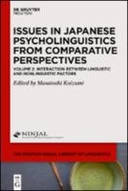Explore

Interaction Between Linguistic and Nonlinguistic Factors
0 Ungluers have
Faved this Work
Login to Fave
Issues in Japanese Psycholinguistics from Comparative Perspectives compiles over 30 state-of-the-art articles on Japanese psycholinguistics. It emphasizes the importance of using comparative perspectives when conducting psycholinguistic research. Psycholinguistic studies of Japanese have contributed greatly to the field from a cross-linguistic perspective. However, the target languages for comparison have been limited. Most research focuses on English and a few other typologically similar languages. As a result, many current theories of psycholinguistics fail to acknowledge the nature of ergative-absolutive and/or object-before-subject languages. The cross-linguistic approach is not the only method of comparison in psycholinguistics. Other prominent comparative aspects include comprehension vs. production, native speakers vs. second language learners, typical vs. aphasic language development. Many of these approaches are underrepresented in Japanese psycholinguistics. The studies reported in the volumes attempt to bridge these gaps. Using various experimental and/or computational methods, they address issues of the universality/diversity of the human language and the nature of the relationship between human cognitive modules. Volume 2, Interaction Between Linguistic and Nonlinguistic Factors, provides studies on the interaction between linguistic and non-linguistic factors. ; Issues in Japanese Psycholinguistics from Comparative Perspectives compiles over 30 state-of-the-art articles on Japanese psycholinguistics. It emphasizes the importance of using comparative perspectives when conducting psycholinguistic research. Psycholinguistic studies of Japanese have contributed greatly to the field from a cross-linguistic perspective. However, the target languages for comparison have been limited. Most research focuses on English and a few other typologically similar languages. As a result, many current theories of psycholinguistics fail to acknowledge the nature of ergative-absolutive and/or object-before-subject languages. The cross-linguistic approach is not the only method of comparison in psycholinguistics. Other prominent comparative aspects include comprehension vs. production, native speakers vs. second language learners, typical vs. aphasic language development. Many of these approaches are underrepresented in Japanese psycholinguistics. The studies reported in the volumes attempt to bridge these gaps. Using various experimental and/or computational methods, they address issues of the universality/diversity of the human language and the nature of the relationship between human cognitive modules. Volume 2, Interaction Between Linguistic and Nonlinguistic Factors, provides studies on the interaction between linguistic and non-linguistic factors.
This book is included in DOAB.
Why read this book? Have your say.
You must be logged in to comment.
Rights Information
Are you the author or publisher of this work? If so, you can claim it as yours by registering as an Unglue.it rights holder.Downloads
This work has been downloaded 69 times via unglue.it ebook links.
- 69 - pdf (CC BY-NC-ND) at Unglue.it.
Keywords
- Bedrohte Sprache
- Cross-Linguistic Comparison
- Endangered language
- Grammar, syntax & morphology
- Historical & comparative linguistics
- Japanese
- Japanisch
- Language
- Linguistics
- Psycholinguistics
- Psycholinguistik
- thema EDItEUR::C Language and Linguistics::CF Linguistics
- thema EDItEUR::C Language and Linguistics::CF Linguistics::CFD Psycholinguistics and cognitive linguistics
- thema EDItEUR::C Language and Linguistics::CF Linguistics::CFF Historical and comparative linguistics
- thema EDItEUR::C Language and Linguistics::CF Linguistics::CFK Grammar, syntax and morphology
- Zwischensprachlicher Vergleich
Links
DOI: 10.1515/9783110778939Editions

